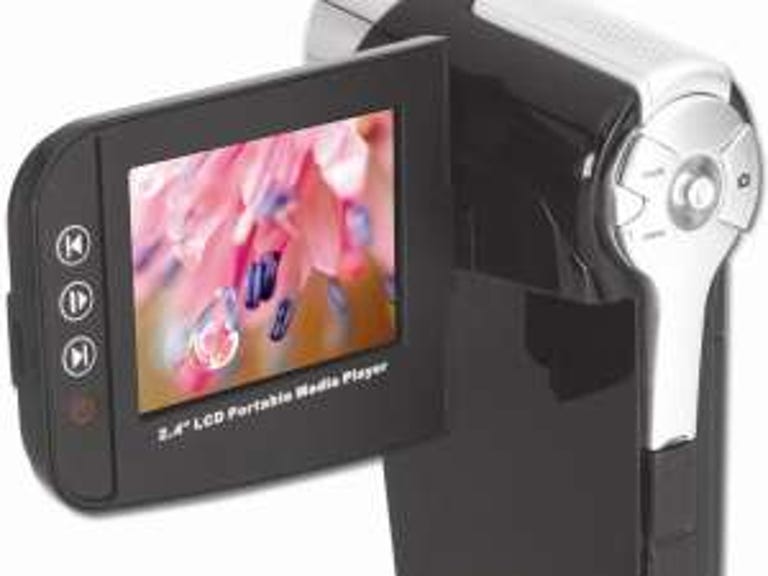 Why You Can Trust CNET
Why You Can Trust CNET Aiptek AHD200 review: Aiptek AHD200
High-definition filming couldn't be simpler with the Aiptek AHD200 camcorder. Plug in a memory card, open the screen and away you go. It's a perfectly decent camcorder for anyone on a budget who's looking to take a compact shooter on holiday or someone ready to start an HD career
The Aiptek AHD200 has to be one of the best deals on high definition camcorders going, at a meagre £150. While Sony, Canon and other manufacturers compete on image quality and features, Aiptek has nipped in with models like this. We gave this affordable camcorder a thorough going-over to see if it's cheap at twice the price or a false economy.
The Good
The Bad
The Bottom Line
Design
The AHD200's design is simplicity itself: you turn the pistol-shaped camcorder on by flipping out the screen, and off by closing the screen or hitting the off button next to the screen. Playback controls are positioned beside the 61mm (2.4-inch) LCD. At the back of the camcorder, the right thumb operates mode and menu buttons, a still shutter release, and a small joystick. The only other controls are a switch on the lens barrel to toggle between portrait/landscape and macro modes, and the record button in the index finger 'trigger' position.

Keep your finger on the trigger that starts and stops recording and you have the advantage over rear-placed record buttons in that it keeps you from covering the flash with your finger. This is a common problem with the pistol form factor.
Although the rear-mounted buttons feel plasticky, the AHD200's overall construction is sturdy, without too much flexing and creaking. The thumb-level joystick is flexible enough to be fun to use, although zooming is brisk and takes practise for sensitive movements. The stick is set in an illuminated well that flashes while recording. This is distracting, but at least it provides a visual cue that the camera is rolling.
Features
The AHD200 doesn't really do features: witness the meagre 2x zoom and fixed focus. As well as video, it takes stills -- but not while filming -- records voice clips and plays MP3s. There are exposure compensation and white balance options, but again these cannot be altered during filming and both require entering the menu.
The method of getting to your images and video is also somewhat fussy. There isn't a direct access to recorded footage; instead, a press of the Mode button takes you into a menu that allows you to scroll to My Works, containing stills, video and voice recordings. Another button press accesses footage. There isn't a dedicated Delete switch either, necessitating more button-pushing.
One letdown on the HD front is the lack of HDMI. You only get USB and component outputs.
Performance
High-definition filming couldn't be simpler. Plug in a memory card,
open the screen and away you go. With a decent card footage is
processed near instantaneously, so it's perfectly feasible to stop and
start recording to save memory.
Video is recorded to SD or SDHC card. The use of removable memory is a concern for HD shooters as it can limit the amount of footage captured: a Kingston 2GB Ultimate SD card will shoot just over an hour, with a PNY 4GB SDHC card managing double that. You'll need at least an SDHC for a wedding and multiple cards for a holiday.
Image quality
Sadly, image quality doesn't match ease of
use. Footage is 1,280x720-pixel H.264 video
at 30 frames per second. Video is passable rather than outstanding. There's more
compression artefacts than we'd like, and panning leads to a certain
amount of motion blur. Colour is consistent, and the fixed focus copes
well with movement.
Low-light performance also sees a lot of noise and loss of detail in dark areas, with high-contrast light sources blowing out highlights.
Conclusion
The Aiptek AHD200 is a high-definition camcorder, but just barely.
Sticking an HD sticker on everything seems to be the technology
industry's latest wheeze, and while this shooter will never compete
with even entry-level Canon or Sony products on image quality or
features, it isn't even trying to. At this price there are few HD
competitors, and if budget is the primary consideration it's a
perfectly decent shooter for the casual holidaymaker or video newcomer.
Edited by Jason Jenkins
Additional editing by Shannon Doubleday


